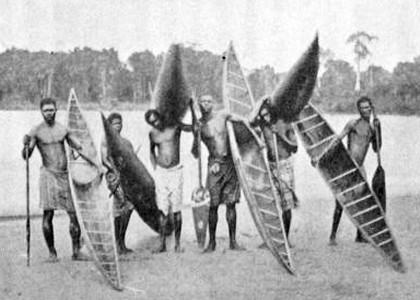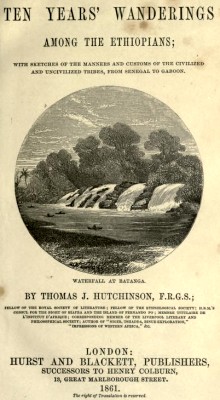
thomas j. hutchinson : canoe surfing in africa, 1861
| home | catalogue | history | references | appendix |
 |
surfresearch.com.au
thomas j. hutchinson : canoe surfing in africa, 1861 |
Open Library
http://openlibrary.org/books/OL7203893M/Ten_years'_wanderings_among_the_Ethiopians
Canoe Surfriding
At Batanga (Cameroon)
Thomas J. Hutchinson observed the local fisherman surfriding in their canoes,
at point along the beach where the waves broke on an extensive
reef.
Apparently, the
conditions on this day were unfavorable for serious fishing, or particularly
suited to canoe surfriding, or a combination of both.
Hutchinson gives
the impression that this is a group of the four or six riders in small
light-weight one-man canoes.
He describes the
paddle-out, take-off, steering with a trailing paddle at speed, and the
inconvienience of the wipe-out, somewhat mitigated by their being "capital
swimmers – indeed, like the majority of the coastal negroes, they may be
reckoned amphibious.".
Sharks are an ocasional
hazard; Hutchinson was told that, shortly before he arrived, a fishman
died after losing a leg to "a prowling shark."
Dawson notes that
:
"Hutchinson’s account
is unique for several reasons.
It is the only one
that describes adults surfing.
Surfing apparently
had not taken any deep cultural meaning, yet these Cameroonian fishermen
seem to have been quite passionate about it.
Like many ancient
Hawaiian and modern surfers, they were ardent enough to risk life and limb
surfing in waters known to contain sharks. "
This is not the first
report of (adult) West Africans riding waves in canoes, although in those
instances the canoe riders are invariably in pursuit of their "industrial
occupation," either in transporting freight or passengers, or in returning
to shore with their haul of fish.
At Batanga, the
canoe riders are clearly riding the waves for pleasure.
Many commentators
over-emphasze the danger to surfriders from sharks, a viewed enthusiastically
embraced by the popular media.
Dawson also adds inthe footnote:
For the photograph Mary H. Kingsley: Batanga Canoes, West Africa, c1899, see below.
Reference
Dawson, Kevin :
Swimming,
Surfing and Underwater Diving in Early Modern Atlantic Africa and the African
Diaspora (20??).
Carina Ray and Jeremy
Rich, eds., Navigating African Maritime History (Published by the
Research in Maritime History book series, Memorial University of Newfoundland
Press, 2009), pp. 81-116.
http://history.unlv.edu/faculty/dawson/Swimming
& Surfing in Africa copy.pdf, viewed 10 April 2013.
Reports
From West Africa
1600 von Lubelfing : Swimming
and Canoes, West Africa.
1602 de Marees : Swimming,
Canoes and Fishing, Guinea.
1604 Ulsheimer : Canoes
and Whaling, West Africa.
1620 Samuel Brun : Canoes,
Rafts, and Fishing, West Africa.
1645 Hemmersam : Float
Boards and Canoes, West Africa.
1669 Muller : Swimming,
Canoes and Fishing, West Africa.
1712 Jean Barbot : Canoes
and Fishing, Guinea.
1735 John Atkins : Canoes
and Fishing, Guinea and Brazil.
1812 Henry Meredith
: Canoe Surfing on Gold
Coast, Africa.
1823 John Adams
: Surfboard Riding on the West
Coast, Africa.
1835 James Edward
Alexander :
West Africa.
1861 Thomas J.
Hutchinson : Canoe Surfing
in Gabon, Africa.
1863 Paul Du
Chaillui : Surf Canoeing,
Africa.
1876 Hugh Dyer
: Surf Boats in West Africa.
1877 John Whitford
: Surf Canoes and Boats,
West Africa.
1891 The Graphic
: Surf Boats, Ghana.
1895 C. S. Smith
: Batanga Canoes, West Africa.
1887 Archer Crouch :
Body Surfing, West Africa.
1887 Alfred Burton
Ellis : Surf Dieties of West
Africa.
1899 Mary H. Kingsley : Canoes
and Fishing, West Africa.
1923 Robert Rattray
: Padua at Lake
Bosumtwi, Africa.
1949 Jean Rouch
: Surf Riding at Dakar, Senegal.
During my few
days stay at Batanga, I observed that from the more serious and industrial
occupation of fishing they would turn to racing on the tops of the surging
billows which broke on the sea shore; at one spot more particularly, which,
owing to the presence of an extensive reef, seemed to be the very place
for a continuous swell of several hundred yards in length.
Four or six of
them go out steadily, dodging the rollers as they come on, and mounting
atop of them with the nimbleness and security of ducks.
Reaching the
outermost roller, they turn the canoes stems shoreward with a single stroke
of the paddle, and mounted on the top of the wave, they are borne towards
the shore, steering with the paddle alone.
By a peculiar
action of this, which tends to elevate the stern of the canoe so that it
will receive the full impulsive force of the advancing billow, on they
come, carried along with all its impetuous rapidity.
Sometimes the
steerer loses the balance of his guiding power; the canoe is turned over;
its occupant is washed out, and the light little piece of wood gives a
few lofty jumps from wave to wave, reminding one of a horse at a steeple-chase,
that, having thrown his rider, takes it into his head (or rather his heels)
to gallop about the country, and jump over ditches on his own account.
Yet despite...these
immersions, no one is ever drowned, as they are capital swimmers – indeed,
like the majority of the coastal
negroes, they
may be reckoned amphibious.
In their piscatorial
excursions, it sometimes happens that a prowling shark, tempted to pursue
the fish which the fisherman is hauling on the line, comes within sight
of the larger bait of the negro leg and chops it off without remorse.
A case of this
kind has happened a very short time before the period of my visit, and
the poor victim had died; but this did not diminish the number of canoes
riding waves, nor render one of the canoe occupants less energetic or daring
than before.
 |
Batanga Canoes, West Africa, c1899. From
|
 |
Ten Years' Wanderings among the Ethiopians with sketches of the manners and customs of the civilized and uncivilized tribes, from Senegal to Gaboon. Hurst and Blackett, London, 1861 Open Library
|

| home | catalogue | history | references | appendix |